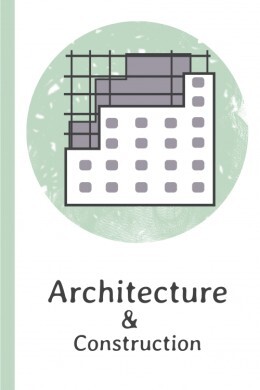Arsitektur dan Konstruksi - Classical Architecture
Di sini Anda akan mempelajari beberapa kata dalam bahasa Inggris yang terkait dengan arsitektur klasik seperti "arcade", "mutule", dan "arch".
Tinjauan
Kartu flash
Ejaan
Kuis

a round or drum-shaped architectural element that is often used for decorative purposes above doors or windows in buildings, or as a part of a dome

drum
a decorative element or symbol carved or inscribed onto a surface

glif, simbol dekoratif
a decorative element consisting of vertical rectangular blocks with three vertical grooves called glyphs

triglyph, elemen dekoratif yang terdiri dari balok persegi panjang vertikal dengan tiga alur vertikal yang disebut glyphs
the triangular upper portion of the entrance of a building, often seen in buildings with Classical architecture

pedimen, bagian segitiga atas pintu masuk
the horizontal, decorative element that rests on top of columns or pillars in architecture

entablatur, hiasan di atas pilar
a covered entrance or porch with columns, typically leading to the main entrance of a building and serving as a decorative architectural feature

portiko, serambi berpilar
a system of architectural design based on specific proportions, column styles, and decorative elements derived from ancient Greek and Roman architecture

orde klasik, gaya arsitektur klasik
a long, open garden or promenade surrounded by covered colonnades or porticoes

xyst, taman panjang terbuka atau promenade yang dikelilingi oleh kolom atau portico tertutup
the lowest horizontal element of a classical entablature, typically located above the columns and below the frieze

architrave, balok lintang
a rectangular space or panel between the triglyphs in a Doric frieze, often decorated with relief sculptures or painted designs

metope, panel persegi panjang di antara triglyph
a horizontal band or section of an entablature in classical architecture, typically found in the Doric order, characterized by alternating triglyphs and metopes

frieze Doric, pita horizontal Doric
a style of ancient Greek architecture known for its simple, sturdy columns without decoration at the top

orde Doric, gaya Doric
an arch-covered passage along the side of a group of buildings

lorong beratap, galeri melengkung
a columned porch or courtyard that surrounds a building or an open space, typically found in ancient Greek and Roman architecture

peristil, deretan pilar yang mengelilingi halaman atau bangunan
a covered walkway or colonnade in ancient Greek architecture, typically consisting of a long row of columns with a roof overhead

stoa, serambi
a small, roofed theater or auditorium in ancient Greece and Rome used for musical performances, poetry readings, and other cultural events

odeon, teater kuno
a large, rectangular building with a central nave, side aisles, and often a raised apse at one end

basilika, bangunan basilika
a room or gallery that is open in one or more sides, particularly one that is attached to a house and faces a garden on one side

loggia, galeri terbuka
the central chamber or inner sanctuary of a temple in classical architecture, where the cult statue or sacred objects were housed

cella, naos
a decorative motif in the form of stylized flower or leaf, typically used in ancient Greek and neoclassical architecture

anthemion, motif anthemion
a series of arches or arcades that are supported by columns or piers, often used in architectural designs to create decorative openings or galleries

arkatur
a decorative ribbon or scroll motif typically found in Renaissance and Baroque styles, often used to display inscriptions or decorative elements

spanduk
a double-curved molding profile featuring a concave upper curve and a convex lower curve, commonly used in classical and neoclassical architecture for decorative purposes

cyma, profil molding lengkung ganda
a semicircular or rectangular recess in a building, often with seating, used for social gatherings or as a decorative architectural feature

exedra, apsis
the topmost platform or step of a classical Greek or Roman temple on which the columns are placed

stylobate, platform teratas kuil klasik
a decorative element or molding that forms a projecting crown or cornice at the top of a structure, typically found in classical or neoclassical styles

corona, mahkota dekoratif
an ornamental element placed on the apex or corners of a pediment or the top of a roof in classical architecture, typically depicting decorative figures or motifs

acroter, elemen dekoratif acroter
a small, often artificial, cave-like structure or enclosed space that is designed for aesthetic or functional purposes

gua, gua buatan
a decorative block or projection that is typically found under the projecting eaves of a classical entablature

mutule, modillon
one of the classical architectural orders characterized by slender, fluted columns with scroll-like capitals adorned with volutes

orde Ionik, gaya Ionik
a classical architectural order characterized by its ornate capital adorned with acanthus leaves, often used in grand and elaborate structures

orde Korintus, gaya Korintus
a decorative molding or projection that runs along the topmost part of a building's exterior wall, typically serving as a crowning element and providing a transition between the wall and the roof

cornice, molding dekoratif
a decorative element used in classical architecture to cover the joints between roof tiles and the eaves of a building, often featuring intricate designs or motifs

antefix, elemen dekoratif arsitektur
a decorative pattern in architecture that features alternating oval shapes and V-shaped forms used in molding or friezes
an open central courtyard or open space, often with a skylight, that is surrounded by a building or enclosed by walls, commonly found in ancient Roman architecture

atrium, pelataran tengah
an open building that is round or oval in shape and has a space in the middle surrounded by several seats, originated in ancient Roman and Greek architecture used for public entertainments such as sports or drama

amfiteater, arena
a simplified form of classical architectural order characterized by a plain and unadorned column with a simple capital and base

ordo Tuscan, gaya Tuscan
a curved symmetrical structure that supports the weight above it, used in bridges or buildings

lengkung, kubah
| Arsitektur dan Konstruksi |
|---|